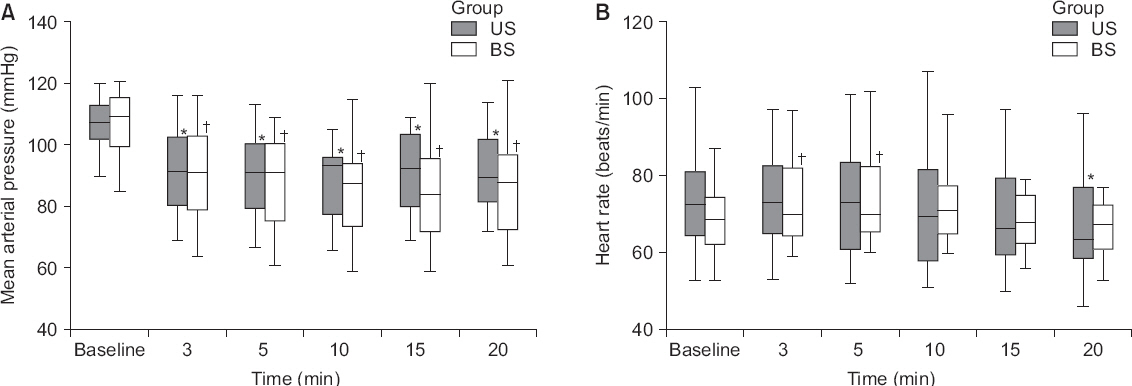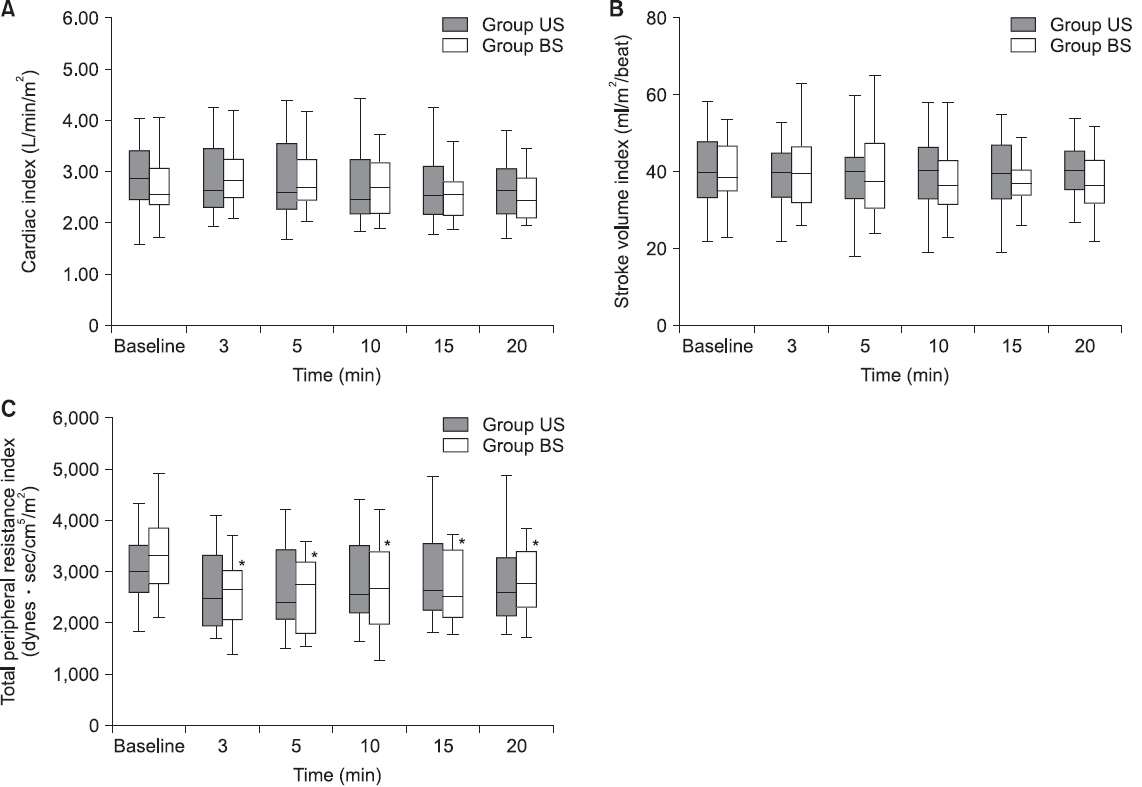Anesth Pain Med.
2019 Jul;14(3):341-346. 10.17085/apm.2019.14.3.341.
Comparison of the immediate hemodynamic changes induced by unilateral and bilateral spinal anesthesia in hypertensive elderly patients
- Affiliations
-
- 1Department of Anesthesiology and Pain Medicine, Jeju National University Hospital, Jeju, Korea.
- 2Department of Anesthesiology and Pain Medicine, Jeju National University School of Medicine, Jeju, Korea. hjanesthesia@empas.com
- 3Jeju National University School of Medicine, Jeju, Korea.
- KMID: 2454821
- DOI: http://doi.org/10.17085/apm.2019.14.3.341
Abstract
- BACKGROUND
The objective of this study was to compare the frequency of hypotension and immediate hemodynamic changes induced by unilateral and bilateral spinal anesthesia in hypertensive elderly patients.
METHODS
Forty hypertensive elderly patients undergoing lower leg surgery were randomly allocated into unilateral (group US) and bilateral spinal anesthesia (group BS). After intrathecal bupivacaine injection, patients in group US were kept in the lateral position for 10 min while patients in group BS were immediately placed in the supine position. Hemodynamic parameters were measured for 20 min by non-invasive cardiac output monitor based on bioreactance.
RESULTS
In both groups, mean arterial pressure was significantly decreased after spinal anesthesia compared to the baseline value. However, frequency of hypotension requiring vasoactive drug was significantly lower in group US (5%) than in group BS (35%) (P = 0.044). The dermatom of sensory block on the operated limb was significantly lower in group US [T10 (10-10)] than in group BS [T8 (7.5-10)] (P = 0.013). In comparison within the group, changes of cardiac index were similar as the baseline value in both groups, although total peripheral resistance index was constant in group US but significantly decreased in group BS.
CONCLUSIONS
Unilateral spinal anesthesia effectively reduced the frequency of hypotension requiring vasoactive drug and affected hemodynamic performance less than bilateral spinal anesthesia.
Keyword
MeSH Terms
Figure
Reference
-
1. KOSIS. Population composition by gender and age. Statistics Korea [serial on the Internet]. 2016. cited 2018 Oct 5. Available from http://www.index.go.kr/potal/main/EachDtlPageDetaildo?idx_cd=1010 .2. KOSIS. Prevalence rate of chronic diseases. Statistics Korea [serial on the Internet]. 2016. cited 2018 Oct 5. Available from http://www.index.go.kr/potal/main/EachDtlPageDetail.do?idx_cd=1438 .3. The Korean Society of Anesthesiologists. Anesthesiology and pain medicine. 3rd ed. Seoul: Ryo Moon Gak;2014. p. 398–9.4. Carpenter RL, Caplan RA, Brown DL, Stephenson C, Wu R. Incidence and risk factors for side effects of spinal anesthesia. Anesthesiology. 1992; 76:906–16. DOI: 10.1097/00000542-199206000-00006. PMID: 1599111.5. Critchley LA. Hypotension, subarachnoid block and the elderly patient. Anaesthesia. 1996; 51:1139–43. DOI: 10.1111/j.1365-2044.1996.tb15051.x. PMID: 9038450.6. Zadeh FJ, Alqozat M, Zadeh RA. Sequential compression pump effect on hypotension due to spinal anesthesia for cesarean section:a double blind clinical trial. Electron Physician. 2017; 9:4419–24. DOI: 10.19082/4419. PMID: 28713516. PMCID: PMC5498709.7. Akhtar MN, Tariq S, Abbas N, Murtaza G, Nadeem Naqvi SM. Comparison of haemodynamic changes in patients undergoing unilateral and bilateral spinal anaesthesia. J Coll Physicians Surg Pak. 2012; 22:747–50. DOI: 12.2012/JCPSP.747750. PMID: 23217477.8. Chohan U, Afshan G, Hoda MQ, Mahmud S. Haemodynamic effects of unilateral spinal anesthesia in high risk patients. J Pak Med Assoc. 2002; 52:66–9. PMID: 12073713.9. Fanelli G, Borghi B, Casati A, Bertini L, Montebugnoli M, Torri G. Unilateral bupivacaine spinal anesthesia for outpatient knee arthroscopy. Italian Study Group on Unilateral Spinal Anesthesia. Can J Anaesth. 2000; 47:746–51. DOI: 10.1007/BF03019476. PMID: 10958090.10. Kelly JD, McCoy D, Rosenbaum SH, Brull SJ. Haemodynamic changes induced by hyperbaric bupivacaine during lateral decubitus or supine spinal anaesthesia. Eur J Anaesthesiol. 2005; 22:717–22. DOI: 10.1017/S0265021505001183. PMID: 16163920.11. Lairez O, Ferré F, Portet N, Marty P, Delmas C, Cognet T, et al. Cardiovascular effects of low-dose spinal anaesthesia as a function of age:an observational study using echocardiography. Anaesth Crit Care Pain Med. 2015; 34:271–6. DOI: 10.1016/j.accpm.2015.02.007. PMID: 26388504.12. Park SY, Kim JH, Rim JC, Kim JA, Lee JH, Choi SR, et al. Comparison of spinal anesthesia between the non-elderly and elderly patients. Anesth Pain Med. 2016; 11:190–4. DOI: 10.17085/apm.2016.11.2.190.13. Hartmann B, Junger A, Klasen J, Benson M, Jost A, Banzhaf A, et al. The incidence and risk factors for hypotension after spinal anesthesia induction:an analysis with automated data collection. Anesth Analg. 2002; 94:1521–9. DOI: 10.1097/00000539-200206000-00027. PMID: 12032019.14. Singla D, Kathuria S, Singh A, Kaul T, Gupta S. Mamta. Risk factors for development of early hypotension during spinal anaesthesia. J Anaesthesiol Clin Pharmacol. 2006; 22:387–93.15. Sen S, Aydin K, Discigil G. Hypotension induced by lateral decubitus or supine spinal anaesthesia in elderly with low ejection fraction undergone hip surgery. J Clin Monit Comput. 2007; 21:103–7. DOI: 10.1007/s10877-006-9062-8. PMID: 17216323.16. Meyhoff CS, Hesselbjerg L, Koscielniak-Nielsen Z, Rasmussen LS. Biphasic cardiac output changes during onset of spinal anaesthesia in elderly patients. Eur J Anaesthesiol. 2007; 24:770–5. DOI: 10.1017/S0265021507000427. PMID: 17462120.17. Rooke GA, Freund PR, Jacobson AF. Hemodynamic response and change in organ blood volume during spinal anesthesia in elderly men with cardiac disease. Anesth Analg. 1997; 85:99–105. DOI: 10.1097/00000539-199707000-00018. PMID: 9212130.18. Critchley LA, Stuart JC, Short TG, Gin T. Haemodynamic effects of subarachnoid block in elderly patients. Br J Anaesth. 1994; 73:464–70. DOI: 10.1093/bja/73.4.464. PMID: 7755705.19. Ngan Kee WD, Khaw KS, Ng FF, Lee BB. Prophylactic phenylephrine infusion for preventing hypotension during spinal anesthesia for cesarean delivery. Anesth Analg. 2004; 98:815–21. DOI: 10.1213/01.ANE.0000099782.78002.30. PMID: 14980943.20. Casati A, Fanelli G, Berti M, Beccaria P, Agostoni M, Aldegheri G, et al. Cardiac performance during unilateral lumbar spinal block after crystalloid preload. Can J Anaesth. 1997; 44:623–8. DOI: 10.1007/BF03015446. PMID: 9187782.21. Casati A, Fanelli G. Unilateral spinal anesthesia. State of the art. Minerva Anestesiol. 2001; 67:855–62. PMID: 11815746.22. Kiasari AZ, Babaei A, Alipour A, Motevalli S, Baradari AG. Comparison of hemodynamic changes in unilateral spinal anesthesia versus epidural anesthesia below the T10 sensory level in unilateral surgeries:a double-blind randomized clinical trial. Med Arch. 2017; 71:274–9. DOI: 10.5455/medarh.2017.71.274-279. PMID: 28974849. PMCID: PMC5585788.23. Squara P, Denjean D, Estagnasie P, Brusset A, Dib JC, Dubois C. Noninvasive cardiac output monitoring (NICOM):a clinical validation. Intensive Care Med. 2007; 33:1191–4. DOI: 10.1007/s00134-007-0640-0. PMID: 17458538.24. Raval NY, Squara P, Cleman M, Yalamanchili K, Winklmaier M, Burkhoff D. Multicenter evaluation of noninvasive cardiac output measurement by bioreactance technique. J Clin Monit Comput. 2008; 22:113–9. DOI: 10.1007/s10877-008-9112-5. PMID: 18340540.
- Full Text Links
- Actions
-
Cited
- CITED
-
- Close
- Share
- Similar articles
-
- A Comparison of the Incidence of Hypotension During Unilateral vs Conventional Spinal Anesthesia with Hyperbaric Bupivacaine
- Hemodynamic effects of norepinephrine versus phenylephrine infusion for prophylaxis against spinal anesthesia-induced hypotension in the elderly population undergoing hip fracture surgery: a randomized controlled trial
- Effect of Intrathecal Fentanyl with Hyperbaric Bupivacaine on Unilateral Spinal Anesthesia for Knee Arthroscopy
- Unilateral Spinal Anesthesia with Hyperbaric Levobupivacaine and Bupivacaine for Lower Limb Surgery
- The Influence of Unilateral Spinal Anesthesia and Conventional Spinal Anesthesia on Sensitivity to Midazolam Sedation



